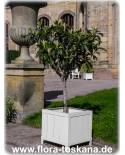Eriobotrya japonica - Loquat, Japanese Plum, Nespoli, Japanese Medlar
Fragrant, woolly white flowers in fall, tasty orange-skinned fruits in spring/summer and attractive leaves all year round: the Japanese Plum (Eriobotrya japonica) offers everything you would expect from a Mediterranean fruit tree in a pot, garden or conservatory!
Loquat (Eriobotrya japonica), also known as Japanese Plum or Nespoli, is a real beauty, especially because of its large attractive evergreen leaves: these are up to 25 cm long, their upside is dark green and they have a velvety white underside. Cultivated in a pot or planted in a greenhouse or conservatory, grafted Loquats produce creamy white flowers starting with the 2nd or 3rd year after grafting. In fall and wintert hey stand together in upright, pyramidal clusters at the ends oft the branches in groups of 30 to 100. They emit a delicate, vanilla-like fragrance. They are usually self-fertile and are pollinated by insects. Within about 90 days they produce plum- to egg-sized, orange-colored fruits that taste like mildly sweet, juicy melons with a firm pulp. The fruit usually contains two seeds that are removed easily, and the skin, which is rich in vitamin A, is eaten along with the fruit. Depending on overwintering, flowering can be delayed until spring, with harvesting in late summer. Depending on the way of grafting and how it is pruned, Loquat grows as multi-stemmed shrub or single-stemmed tree with a compact, broad-oval crown. It is a very robust plant: As a container plant it can be moved outdoors early in the year and often do not need to be brought back indoors until November. Loquats can cope with a very broad range of temperature and so it is possible to winter them in a bright and large room. Note: always make sure the soil is moist!
![]() Quality: many & delicious & exotic fruits from own harvest; harvest even with young plants (due to grafting); round crown; evergreen; robust & cold tolerant; can be wintered cold or warm
Quality: many & delicious & exotic fruits from own harvest; harvest even with young plants (due to grafting); round crown; evergreen; robust & cold tolerant; can be wintered cold or warm
![]() Use: in pots from April/May outdoors on balcony & terrace – with overwintering indoors; all year round in a heated greenhouse or conservatory
Use: in pots from April/May outdoors on balcony & terrace – with overwintering indoors; all year round in a heated greenhouse or conservatory
Data sheet
- Family
- Rosaceae
- Origin
- Asia (mediterranean)
- Flowering period
- Autumn
- Color of flowers
- White
- Fruits
- Edible fruits
- Fragrance
- Fragrant flowers
- Growth
- Tree or shrub
- Location
- Sunny
- winter temperature
- 10 (±10)°C
- Minimum temperature
- -10 °C
- Hardiness Zones
- 8
- Height
- 4 - 5 m
You might also like
Customers who bought this product also bought:





























































